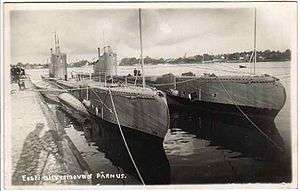Estonian Navy
The Estonian Navy (Estonian: Eesti Merevägi) are the unified naval forces among the Estonia Defence Forces.
| Estonian Navy | |
|---|---|
| Eesti Merevägi | |
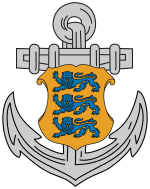 | |
| Active | 1918–1940, 1991–present |
| Country | |
| Branch | Navy |
| Part of | Estonian Defence Forces |
| Headquarters | Miinisadam |
| Motto(s) | Estonian: "Mere kutsel - mere kaitsel!" English: "Call of the Sea – Call to Defend"[1] |
| Anniversaries | 21 November |
| Engagements | Estonian War of Independence |
| Commanders | |
| Commander of the Estonian Navy | Commodore Jüri Saska |
| Commander of the Naval Base | Commander Rain Terras |
| Commander of the Naval Flotilla | Commander Ivo Värk |
| Notable commanders | Admiral Johan Pitka |
| Insignia | |
| Ensign |  |
| Jack | 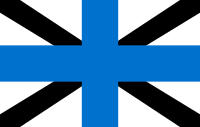 |
With only four commissioned ships and displacement of under 10,000 tonnes, the Estonian navy is one of the smallest navies in the world. Ship prefix is EML (Eesti Mereväe Laev/Estonian Navy Ship). The Estonian Navy has been reduced severely since the second half of the decade mainly due to insufficient maintenance, lack of funding and thereby training of personnel and timely replacement of equipment. Another possible setback could be attributed to Estonia's domestic lack of maritime defence policy strategy as the current navy neither operates a single traditional warship that could perform defensive or offensive operations nor coastal defense capabilities and maritime landing operations along its long and island rich territorial waters. The Estonian Navy has participated numerous times in NATO's naval joint-exercises.
History
Interwar period
Foundation
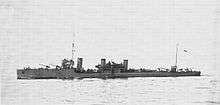
The Merevägi was founded on November 21, 1918. The foundation and development of the Estonian Navy rely greatly on the Royal Navy which operated in the Gulf of Finland as an ally to Estonia during the Estonian War of Independence. The first Estonian navy warships were the destroyers Lennuk and Wambola and were gifts from the UK's Royal Navy after they had been captured from the Russian Baltic Fleet in 1919.
Marine Infantry
The Meredessantpataljon was a short-lived marine infantry - Naval landing battalion of the Estonian Defence Forces subject to the Estonian Navy. The battalion was created from the crews of the Estonian surface warships and was based in Tallinn.
Coastal batteries
Since the end of the 19th century, the Russian Empire began to build coastal fortresses and naval strongholds in Estonia which was annexed to the empire after the Great Northern War in 1721. Tallinn, having been historically an important trading center between the East and the West, became one of the main naval bases of the Imperial Russian Baltic fleet. A systematic coastal defence network and naval gun installations were ordered, and the construction works began at the end of the 1890s.
During the Estonian War of Independence and after the Treaty of Tartu the Estonian Navy began to rebuild and develop the coastal defence network. From 1918 to 1940 Estonia invested millions of kroons into the renovation and development of the coastal defence. By 1939 the coastal batteries presented a considerable naval force and were considered among the Estonian Navy elite forces. During World War II and later the Soviet occupation of Estonia, little has remained of the former coastal defence lines and fortifications. Today some buildings and firing positions can be seen at various places of which the best-preserved ones are located on the island of Aegna.
After restoration of independence
20th century
In 1998 the Baltic Naval Squadron BALTRON was inaugurated. The main responsibility of BALTRON is to improve the co-operation between the Baltic States in the areas of naval defence and security. Constant readiness to contribute units to NATO-led operations is assured through BALTRON.
Each Baltic state appoints one or two ships to BALTRON for certain periods and staff members for one year. Service in BALTRON provides both, the crews and staff officers, with an excellent opportunity to serve in an international environment and acquire valuable experience in mine countermeasures. Estonia provides BALTRON with on-shore facilities for the staff.
Since 1995 Estonian Navy ships have participated in most of the major international exercises and operations carried out in the Baltic Sea. Even though it was not until 1993 when the Navy was re-established, and despite the fact that it incorporates one of the smallest fleets in the world, the young crews of the Navy ships have demonstrated excellent interoperability during international exercises and have proved to be equal partners with other navies.
21st century
From May 2005 to March 2006, EML Admiral Pitka was assigned as the Command and Support Ship of NATO's Standing NRF Mine Countermeasures Group 1 which is part of the NATO Response Force's maritime capability.[2] ENS Admiral Pitka was the first vessel from the Baltic navies to be part of the force. SNMCMG1 is also one of the Estonian Navy's main NATO partners.
Organisation
Operating forces
The top priority for the Estonian Navy is the development of mine countermeasures capability that is also one of the Navy's peacetime responsibilities: during World War I and World War II more than 80,000 sea mines were laid in the Baltic Sea. Since 1995 a number of mine clearance operations have been carried out in Estonian waters by the Estonian Mineships Division in close co-operation with other navies of the Baltic Sea region in order to find and dispose of ordnance and contribute to safe seagoing.[3]
The Estonian Navy uses a small number of different vessels and weapon systems. Since the restoration of the Estonian Defence Forces on 3 September 1991 and the Estonian Navy on 1 July 1993, the naval force has developed tremendously. Then-Commander Estonian Naval Defence Forces, Commodore Roland Leit, was interviewed by Jane's Defence Weekly on 9 July 1994. 'When the Soviet Navy left the Tallinn Naval Base, they sabotaged the facilities and scuttled about 10 of their ships in the harbour. They broke all the windows, all the heating, and all the electrical equipment. When they came in 1939, they took over our port facilities in good order. Now they are leaving us a mess, he said bitterly.' 'We got nothing from the Russian Navy. The Griff class patrol craft we got not from them but from a Russian firm that had bought the hulls first. Their navigation and radio systems are broken, too. We hope to have it all repaired and bring the craft into service before the end of the year.'[4]
Although the Soviet legacy's clean-up and military infrastructure rebuilding has taken most of the defence budget resources away from the Navy, the armament and equipment has improved a great deal.
Ships
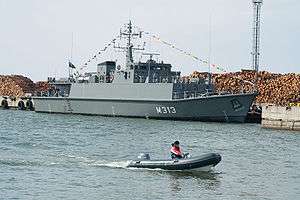
Although the Estonian Defence Forces have a relatively small selection of marine vessels, the Navy still has a variety of different light-combat craft, coastal patrol-craft and support vessels. The first crafts that entered the service in the restored Estonian Navy in 1993 were mainly German background mine-layers and mine-hunters. Within the last 15 years, the Navy logistics support has increased year by year. Most of the modern navy vessels have either been received as foreign aid or been bought from Germany, Finland, United Kingdom and Denmark. In 2006, Estonia purchased three Sandown-class minehunter from the UK to enhance the Estonian Navy's mine-hunting capabilities.[5]
In 2012, the Estonian Navy received a former Estonian Maritime Administration vessel EVA-321. It was renamed "Lood" (A530) and became a diving support vessel.[6]
In September 2013, it was reported that the Estonian Navy was interested in acquiring the 1979-built Finnish minelayer Pohjanmaa that had been decommissioned by the Finnish Navy and was offered for sale.[7] However, all of this speculation came to nought; in March 2016, a Finnish State-owned company (Meritaito) acquired the vessel.
In July 2018, it was reported that three Sandown-class minehunters were set to be modernized between 2018 and 2019. The modernization would include improvements in mine clearance and marine surveillance capabilities. The estimated cost of the project would be €30 million.[8]
In April 2020, the Ministry of Defence announced that it would buy two force protection patrol boats. The boats would be manufactured by Baltic Workboats AS for a total sum of €3.9 million. They would enter service in 2021 and would be used for force protection at sea and in ports, and could also provide support for other agencies, including the Police and Border Guard Board.[9]
Bases
The “Merevägi” has operated a number of naval bases, and war harbors most of them being located on the western coast and the islands. Until 1939 there were more than ten smaller and bigger war harbors and bases; including Aegna, Paldiski, Virtsu, Rohuküla, Mõntu, Kuressaare, Kõiguste, Papisaare, Jaagurahu, Tagalaht, Küdema, Sõru, Kärdla, Kallaste, Mustvee and Tallinn harbor. Currently, there is only one major naval harbor Miinisadam which located in northern Tallinn. The Miinisadam is a base for the Mineships Division.
Personnel
Most Estonian Navy officers have been trained in European or American naval academies (notably the US Naval Academy). In 2003, the Navy established its own Centre of Naval Education and Training (CNET) to train junior petty officers.
Each Baltic State shares its limited training resources with the others. For instance, Estonia provides communications training at the Baltic Naval Communications School in Tallinn, and Latvia hosts a common Baltic Naval Diving Training Centre in Liepaja.
See also
- Finnish–Estonian defense cooperation
References
- "Estonian Navy". mil.ee. Retrieved 2018-02-14.
- "Response Force Mine Countermeasures Group 1". Archived from the original on 2008-02-03. Retrieved 2008-02-01.
- "Estonian Navy mine warfare". Archived from the original on August 31, 2009.
- Joris Janssen Lok, The Jane's Interview with Commodore Roland Leit, Jane's Defence Weekly, 9 July 1994, p.32
- "HMS SANDOWN handed over to Estonian Navy". www.shippingtimes.co.uk. 27 April 2007. Retrieved 4 July 2018.
- "Merevägi tänapäeval". mil.ee (in Estonian).
- Viro kiinnostui miinalaiva Pohjanmaasta – neuvotteluja käydään syksyllä. Turun Sanomat, 20 September 2013. Retrieved 2013-09-20.
- Whyte, Andrew (4 July 2018). "Estonian Navy to spend €30 million on minehunter modernisation". news.err.ee. Retrieved 4 July 2018.
- "Navy to buy force protection boats from Saaremaa company". news.err.ee. ERR. 18 April 2020.
